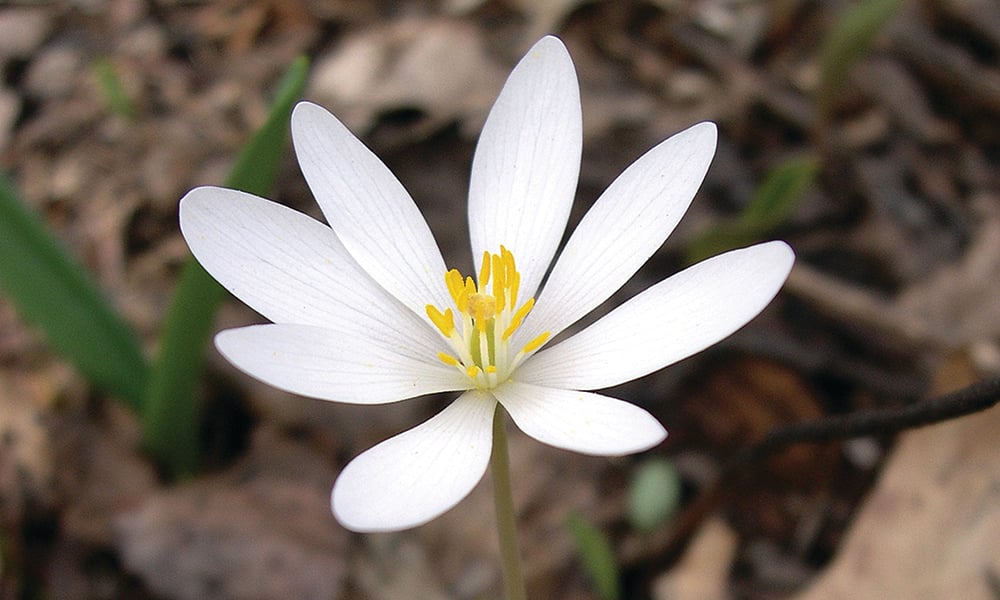
Of all the seasonal blooms, spring wildflowers seem to capture our hearts and attention the most, likely because they’re the first we see after months of drab landscapes. Most grow in woodlands and for that reason are short-lived, or “ephemeral.” They must sprout, grow, flower, fruit, and set seeds before the trees leaf out and block the sun. Some spring flowers are a memory by summer, but a few produce leaves that last into autumn. Below are a few you’ll see this season, so enjoy them while they last.
Spring beauty (Claytonia virginica)
Spring beauties are low-growing ephemerals that can form large colonies. Each plant has a pair of leaves near the base and five-petaled flowers that range from white to pink. The petals often have prominent pink veins, which are referred to as “bee lines” because they direct bees to the source of nectar. Do not expect to see these flowers open on cold, cloudy days. They conserve their energy and only open on sunny, warm days when pollinators are active. Spring beauties can be found at Waterfall Glen, Fullersburg Woods and Danada forest preserves.
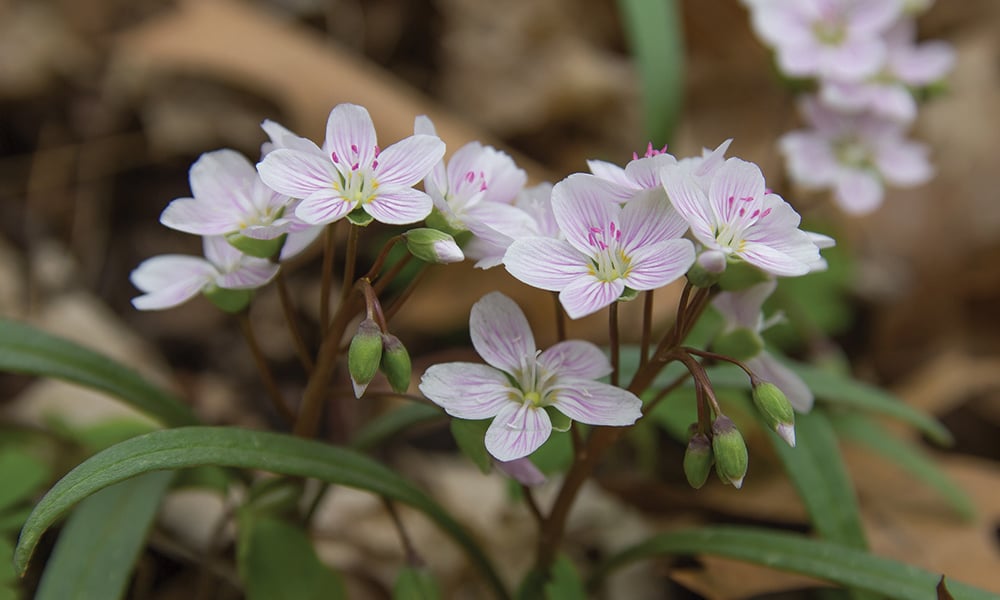
Spring beauty. Photo courtesy Brett Whaley.
Toothwort (Dentaria laciniata)
Toothwort grows 3- to 10-inches tall, sometimes in large groups. Each flower has four petals that form a cross. Young plants have one leaf that grows at the base of the stem and stores energy for next year’s growing season. Mature plants have three leaves that surround the stem right below the clusters of white flowers. Each of these leaves has three to five narrow lobes with prominent teeth along the edges. Toothwort can be found at Fullersburg Woods, Greene Valley, and Herrick Lake forest preserves.
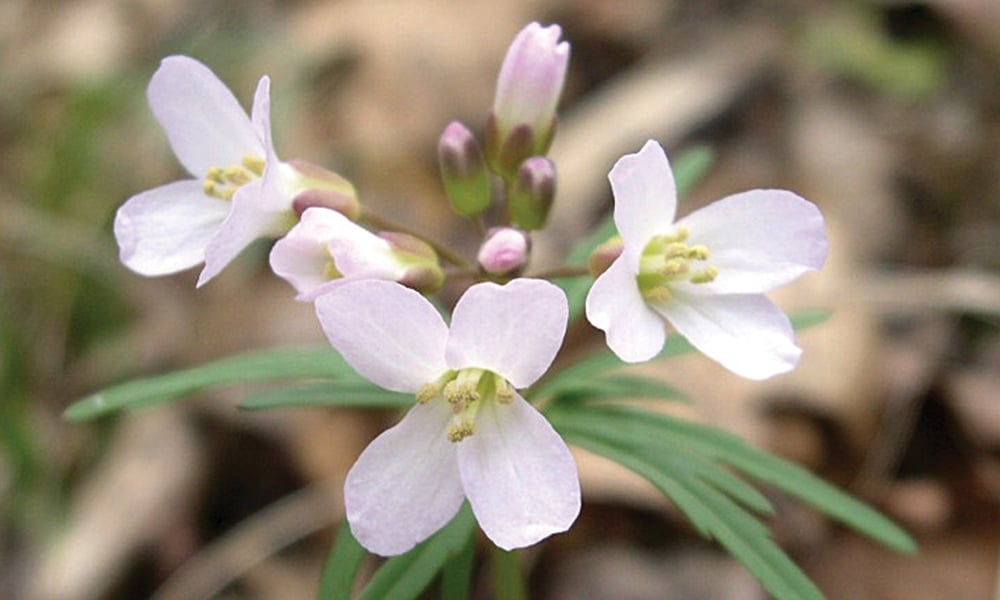
Toothwort. Photo courtesy Jay Sturner.
Dutchman’s breeches (Dicentra cucullaria)
This is a great example of a flower that gets its common name from its shape. Dutchman’s breeches look like crisp pantaloons hanging upside down. They’re usually white with yellow tips but can be tinged pink. The flowers grow on a long stalk that rises above grayish-green, deeply lobed, fern-like leaves. This plant disappears entirely by summer. Dutchman's breeches can be found at Maple Grove, Meacham Grove, and Fullersburg Woods forest preserves.
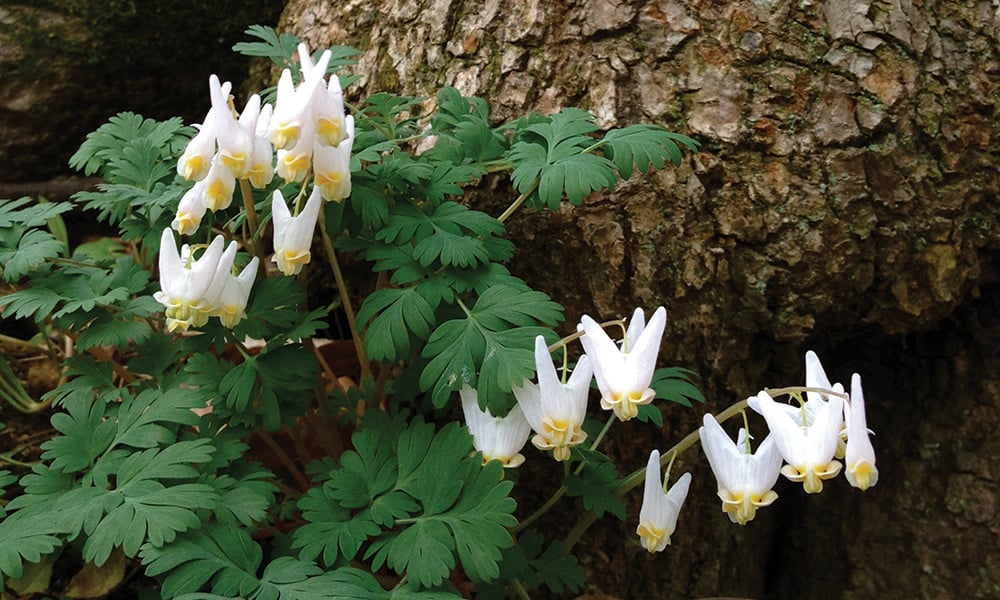
Dutchman's breeches. Photo courtesy Fritz Flohr Reynolds.
Bloodroot (Sanguinaria canadensis)
Bloodroot, one of the area’s earliest arrivals, can start to bloom as early as March. It has eight to 16 straplike petals that form bright white flowers 1.5 to 3 inches across. At flowering time, the leaves are small and remain wrapped around the stalk. After the short flowering period, though, they unfurl, reaching 3 to 5 inches in length and width. Unlike some ephemerals, bloodroot leaves remain throughout the growing season. Bloodroot can be found at Maple Grove, Meacham Grove, and Fullersburg Woods forest preserves.
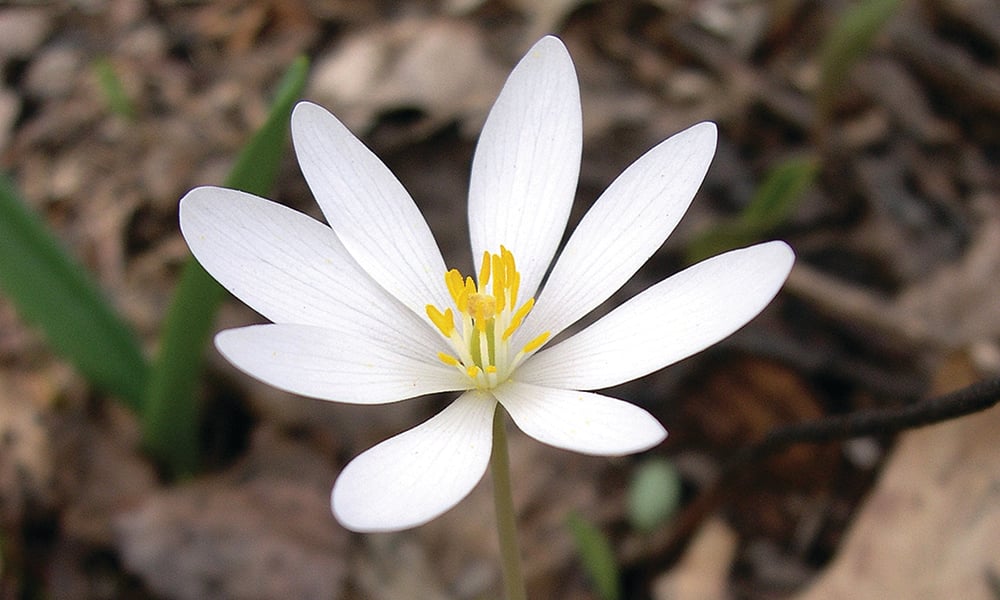
Bloodroot. Photo courtesy Jay Sturner.
Red trillium (Trillium recurvatum)
The “tri” in trillium refers to the fact that all plants in this group have leaves, petals and sepals that grow in threes. Red trilliums can grow up to 15-inches tall but usually top out at 6 to 8 inches. The reddish stem is topped by three evenly spaced, mottled leaves; the flower’s three maroon petals stand erect and curve inward. It’s the most common trillium in the county and has a blooming period that can last several weeks. Red trillium can be found at Waterfall Glen, Fullersburg Woods, and Churchill Woods forest preserves.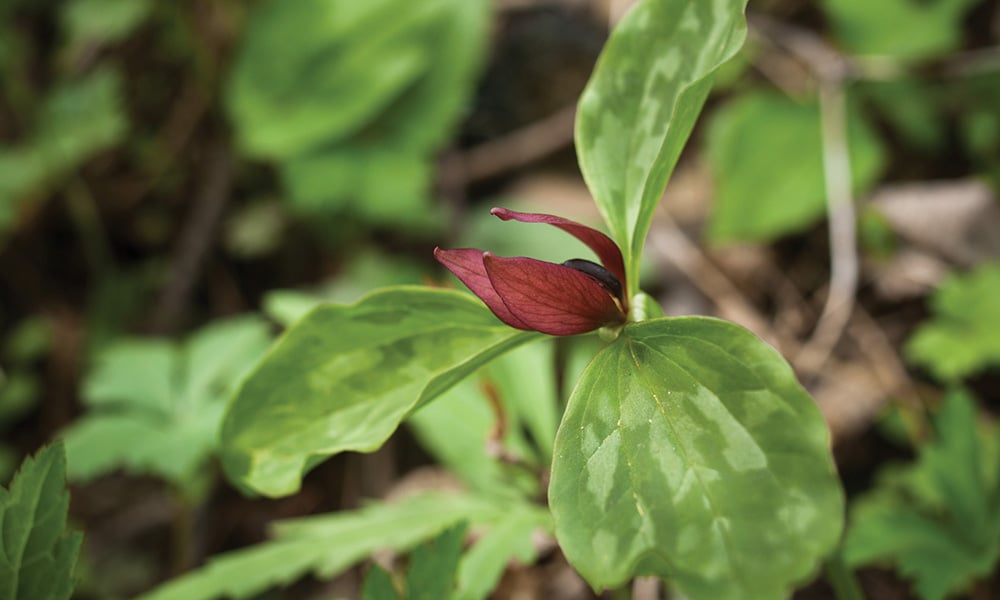
Red trillium. Photo courtesy Justin Meissen.
Bellwort (Uvularia grandiflora)
Bellwort is a distinctive-looking 1- to 2-foot-tall plant. Its yellow bell-shaped flowers are about 1- to 2-inches long and point toward the ground. The main stem divides into several side stems, and the top of the plant usually nods over. Each leaf is “perfoliate,” which means it completely surrounds the stem as if the stem grew right through it. Bellwort flowers last about two weeks, but the stems and leaves remain through summer. Bellwort can be found at Churchill Woods, Fullersburg Woods, and Greene Valley forest preserves.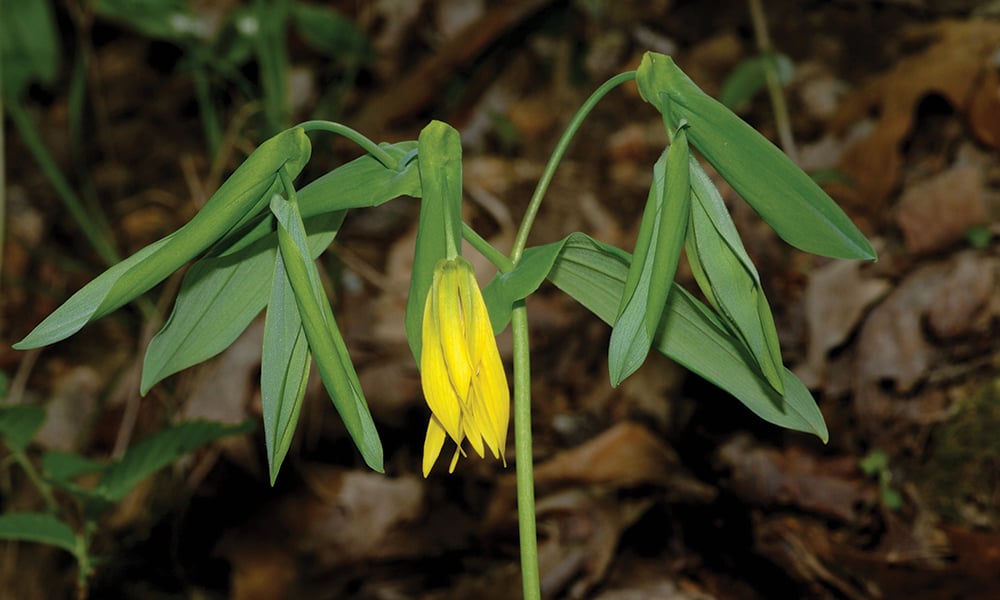
Bellwort. Photo courtesy Nicholas Turland.
Swamp buttercup (Ranunculus septentrionalis)
Each leaf on this 6-inch plant is divided into three leaflets with toothy edges. The flowers are about an inch wide and have five waxy yellow petals. As the flowers mature, the petals turn pale yellow and then eventually white before falling off. After blooming, swamp buttercup can spread 2- to 3-feet across the ground by setting roots where the stems touch the soil. Swamp buttercup can be found at Blackwell, Waterfall Glen, and Fullersburg Woods forest preserves.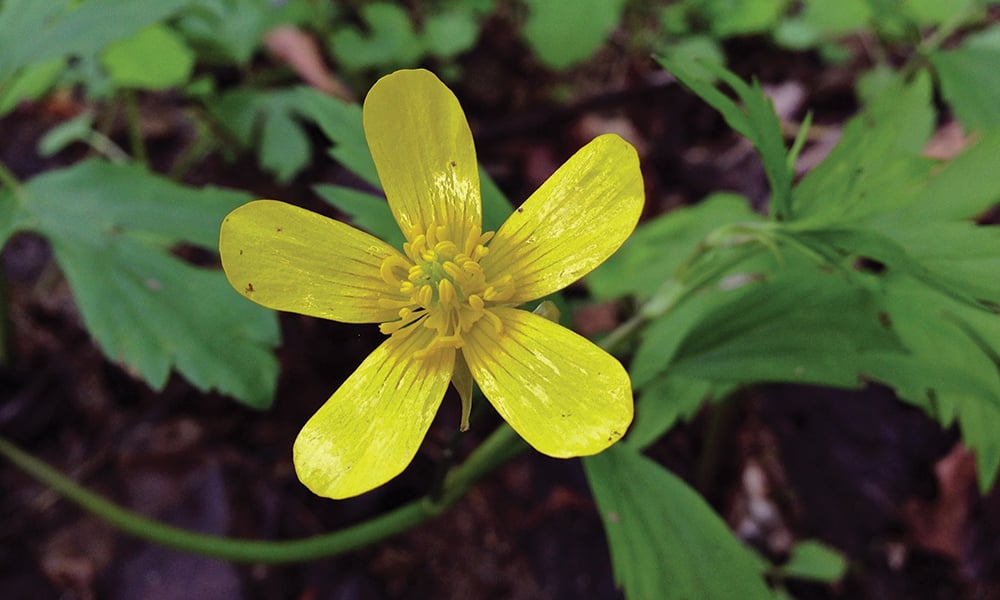
Swamp buttercup. Photo courtesy Fritz Flohr Reynolds.
Rue anemone (Anemonella thalictroides)
This delicate 4- to 8-inch-tall plant is usually found in oak woodlands. Each of its leaves has three shallow lobes. The bright white flowers are sometimes tinged with pink and appear in loose clusters, each on its own stem, which makes the plants especially attractive. The petals are not “true” petals but are “sepals.” The sepal is the leaflike outer part of a flower that protects or supports the bud. They can be inconspicuous and green, but on some petal-less flowers like the rue anemone, they’re colorful petal stand-ins. Rue anemone can be found at Blackwell, Greene Valley, and Fullersburg Woods forest preserves.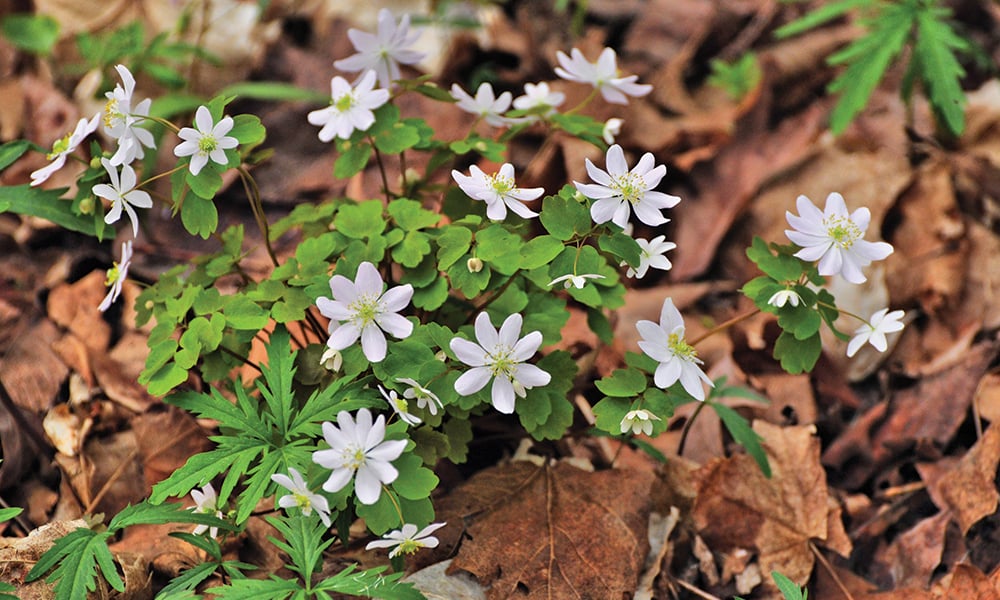
Rue anemone. Photo courtesy Julie Falk.
Yellow violet (Viola pubescens)
The yellow violet is the only violet in DuPage County woodlands with flowers of this color. Yellow violets have “leafy” stems, meaning they have both “basal” leaves that grow from the base of the stem and smaller leaves that grow on the stem further up. (Most violets in the area, such as the common blue violet, Viola sororia, have only basal leaves.) Yellow violet can be found at Meacham Grove, Greene Valley, and Fullersburg Woods forest preserves.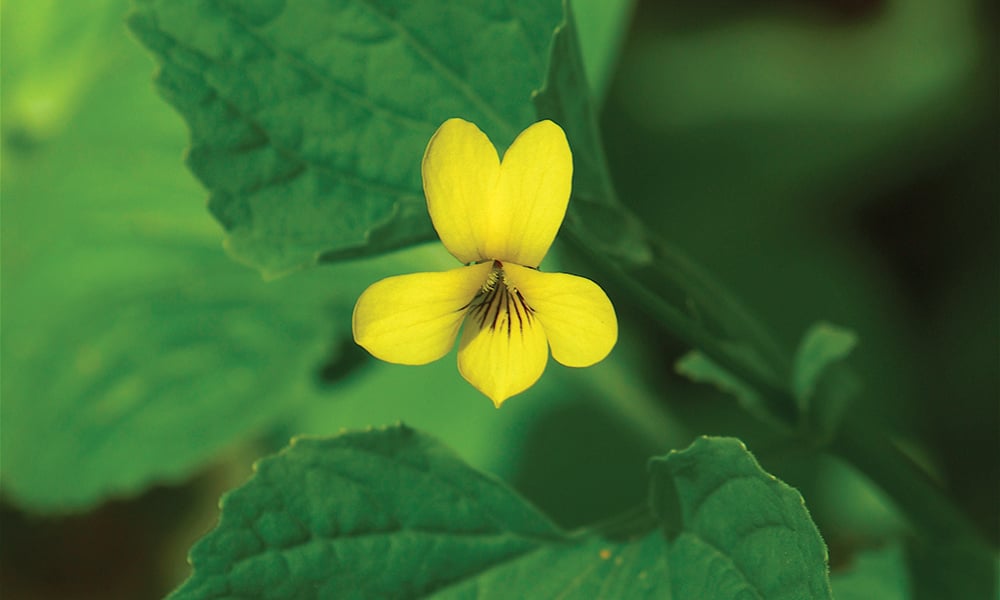
Yellow violet. Photo courtesy Dan Mullen.
May apple (Podophyllum peltatum)
May apples are 12- to 18-inches tall and have one or two deeply divided pale-green umbrellalike leaves. Plants with only one leaf do not bloom. Those with two leaves produce a single flower, which emerges from the spot where the stem meets the leaf stalks. The 1.5-inch flowers have six to nine white petals. May apples often grow in dense colonies that exclude other spring wildflowers, and their leaves and fruits are evident well into summer. May apple can be found at Churchill Woods, Fullersburg Woods, and Herrick Lake forest preserves. 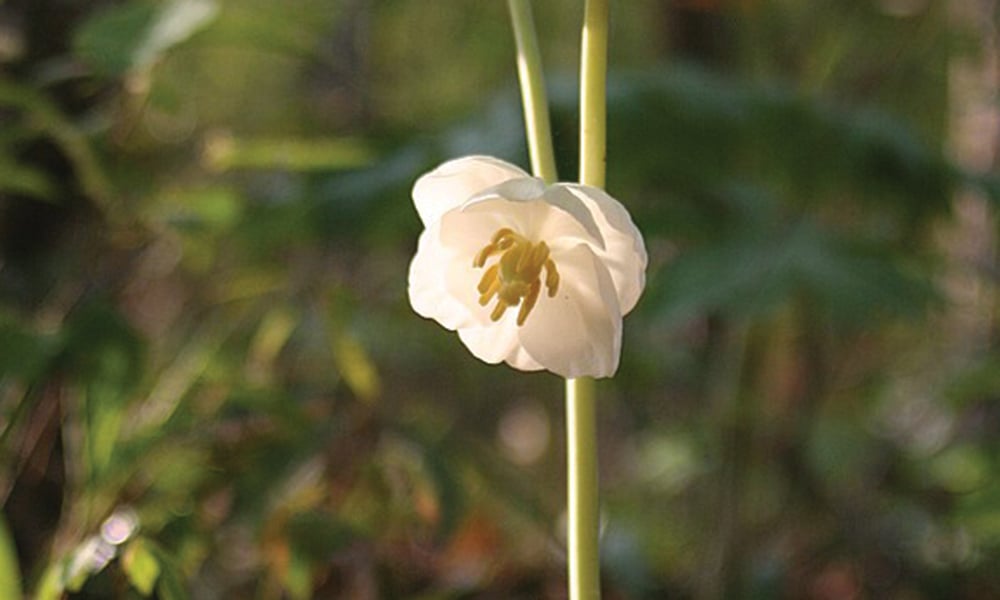
May apple. Photo courtesy Lance and Erin.
Go Native in Your Garden
Once you've mapped out your native landscaping, you can shop in person for native flowers, shrubs and trees at our annual Native Plant Sale May 13 and 14 at Mayslake Peabody Estate in Oak Brook.
Support the Friends of the Forest Preserve District of DuPage County and purchase a ticket for an exclusive in-person Native Plant Pre-Sale May 12.
This year's sale will be in-person only. Details, including a list of plants and info on tickets for the May 12 exclusive pre-sale, are available at dupageforest.org/native-plant-sale. Ticket sales begin April 11 at 8 a.m. for the exclusive early-bird shopping event.